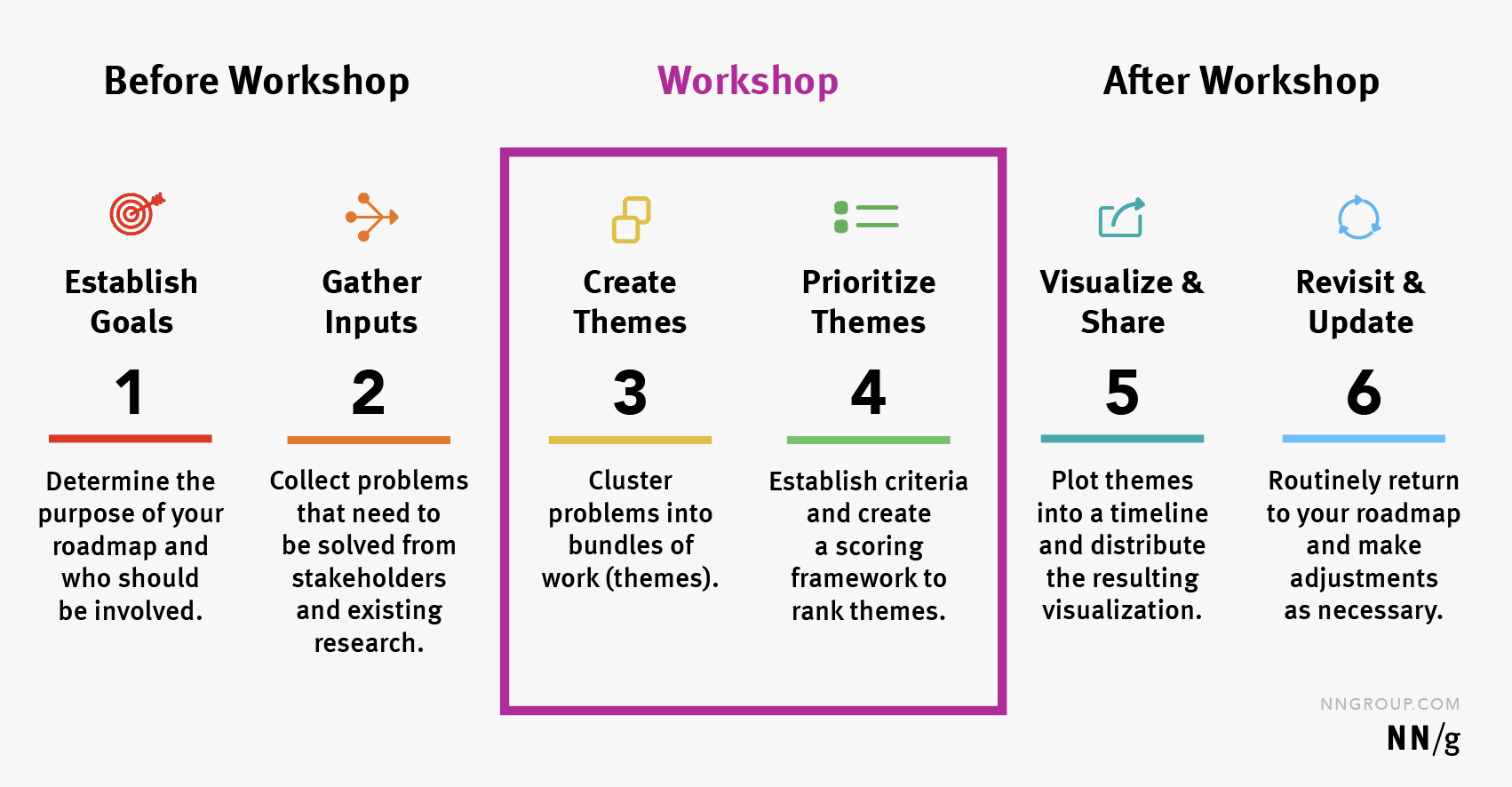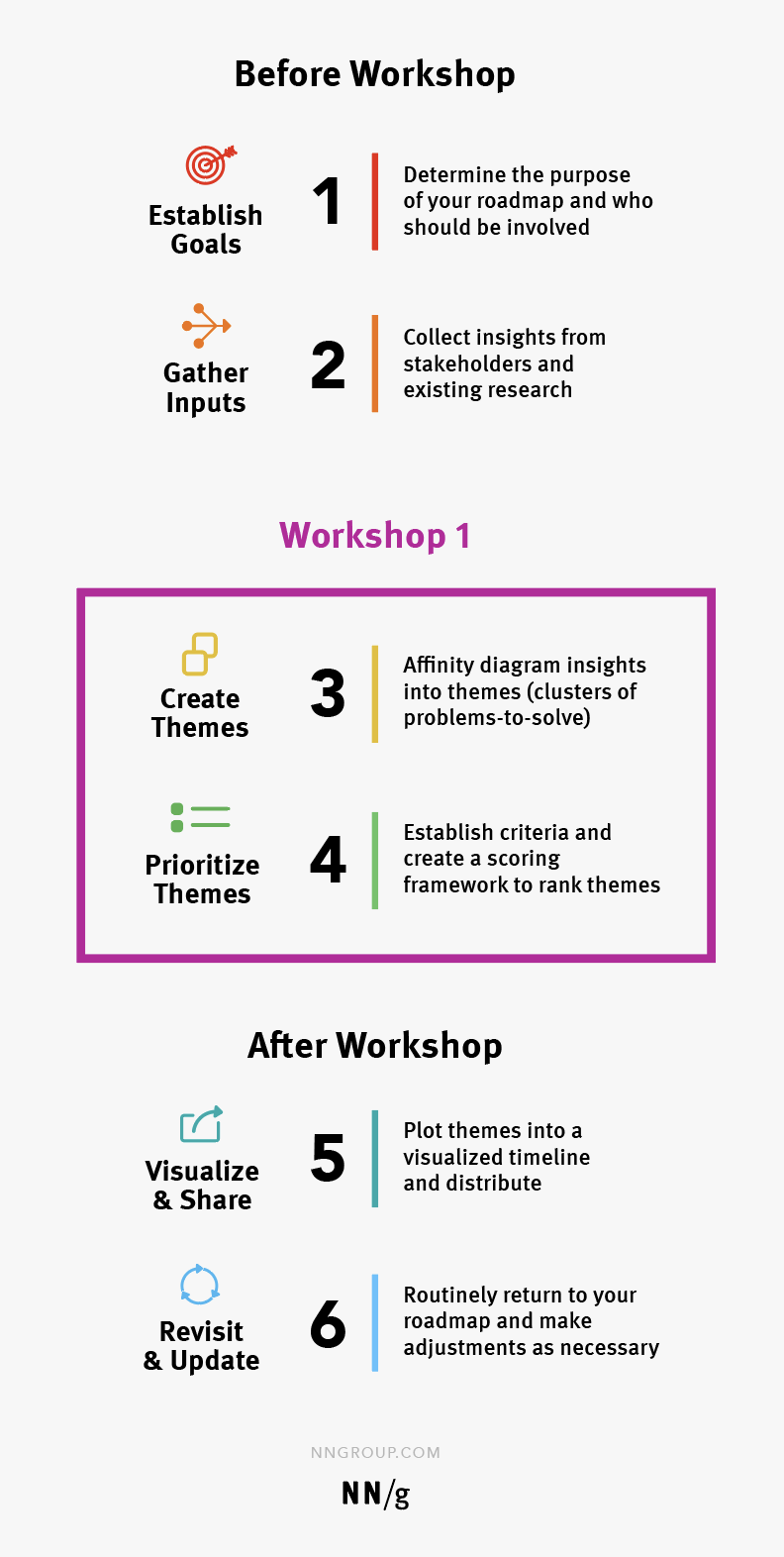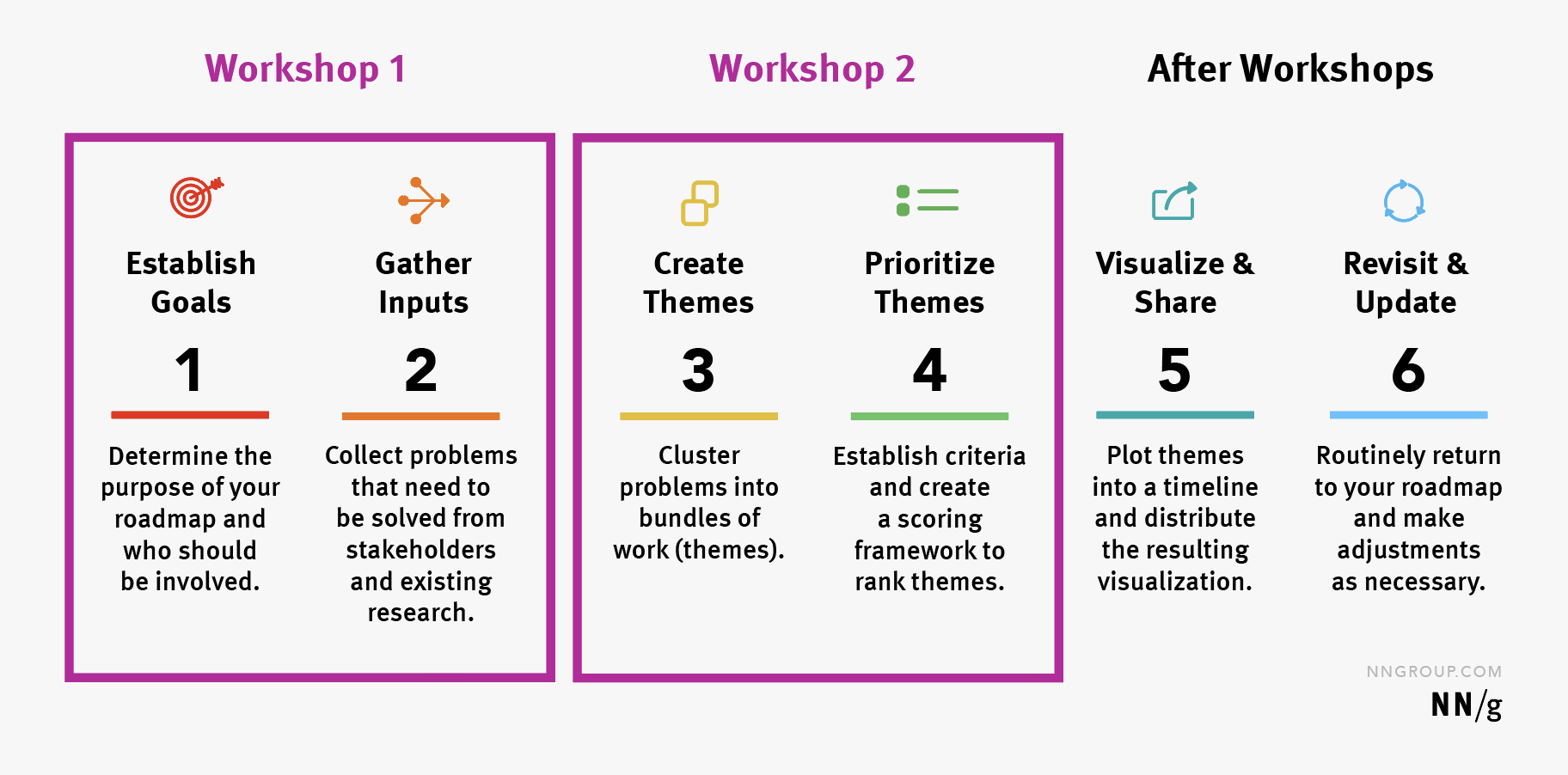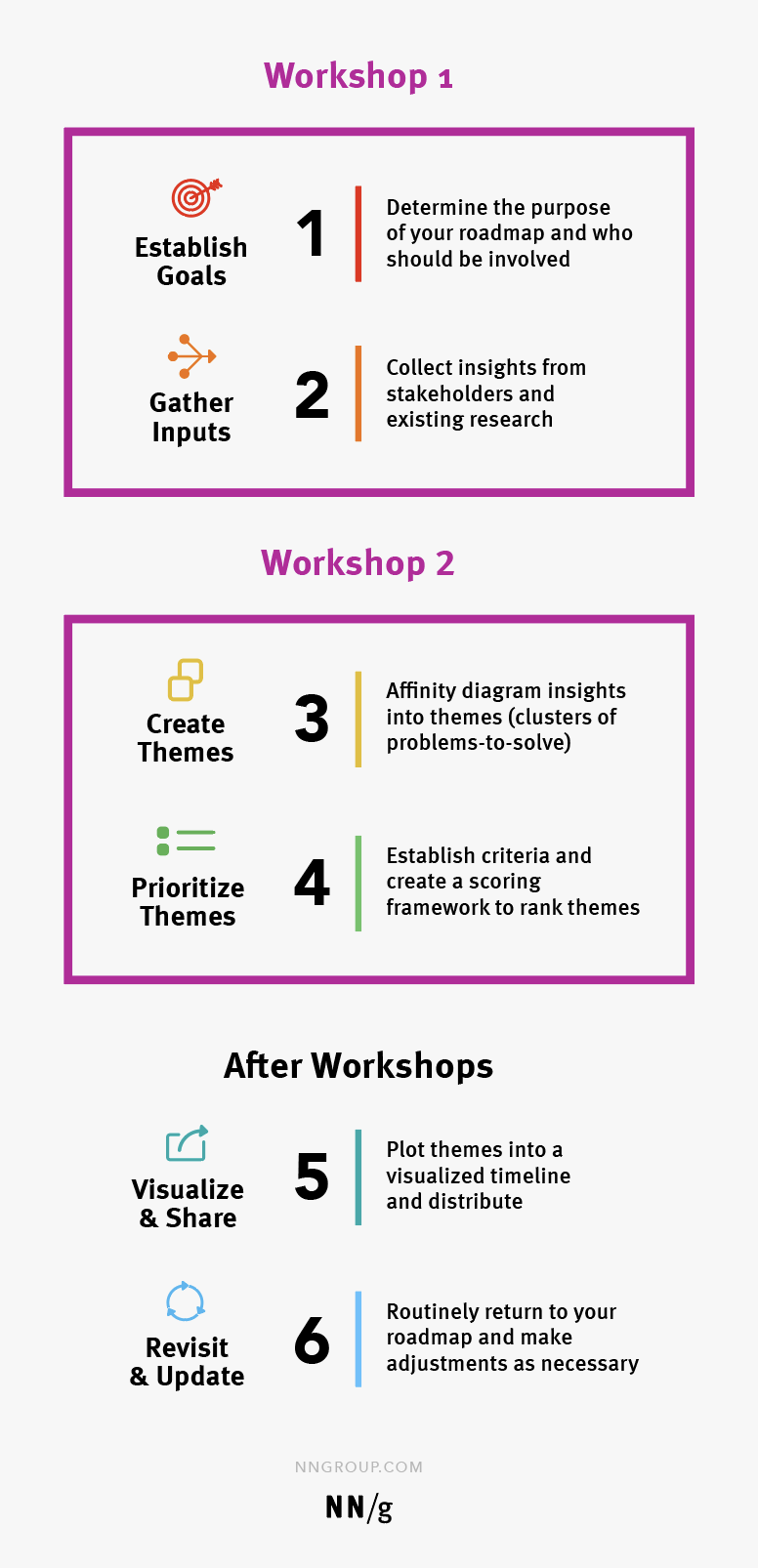A UX roadmap is a strategic, living artifact that aligns, prioritizes, and communicates a UX team’s future work and the problems it needs to solve. Roadmaps should make realistic promises, value functionality over pretty visuals, and be strategic documents instead of feature-specific release plans.
Roadmaps must be created collaboratively in order to be effective. Otherwise, regardless of how well-constructed the roadmap is, it may stay unused.
When to Workshop in the Roadmapping Process
Successful roadmapping includes 6 key high-level steps: establishing goals, gathering inputs, creating themes, prioritizing themes, visualizing and sharing, and revisiting and updating.


A roadmapping workshop executes steps 3 and 4 of the overall process. Establish goals and gather inputs on your own, then conduct a workshop with key stakeholders and fellow team members. Follow up with a finished roadmap shared with all stakeholders and workshop participants.
The newer you are to facilitation, the smaller you should start — include just 3–6 people in this process. If you’re comfortable with workshop facilitation, you can expand the size of the workshop audience to 6–12 people and tackle a higher-level roadmap.
Before Workshop
Pre-workshop work is critical for the success of the workshop and involves the following steps:
- Identify a primary purpose for roadmapping.
- Identify a single, primary purpose for your roadmapping initiative. A clear goal will keep it focused and will establish clear priorities as you move through the process. Common roadmap purposes include:
- Increasing team awareness
- Enabling crossdisciplinary visibility and alignment
- Educating others on the UX process
- Managing bandwidth and resource allocation
- Identify a single, primary purpose for your roadmapping initiative. A clear goal will keep it focused and will establish clear priorities as you move through the process. Common roadmap purposes include:
- Choose a scope and establish a core team.
- Roadmaps that include UX work can have 3 scopes: product, field, and specialty. Identify which scope is best for your objective. Based on your primary purpose and chosen scope, establish a crossdisciplinary core team made of people who have insight, expertise, or responsibility over the future work’s completion and secure their time to participate in the key workshop.
- Gather inputs from existing research.
- Collect existing information that could help identify and prioritize potential problems to solve within your chosen scope:
- Previous roadmaps (including higher-level product roadmaps (or any higher-level roadmaps)
- Journey maps and service blueprints
- Qualitative or quantitative user research
- Customer- or employee-support logs
- Market-research surveys or brand audits
- Collect existing information that could help identify and prioritize potential problems to solve within your chosen scope:
- Plan the workshop logistics.
- Make key logistical decisions and communications prior the workshop:
- Determine your tools and materials. We recommend using sticky-notes (either physical or digital) which lend themselves well to the clustering required in the workshop.
- Assign roles. Heading into the workshop, assign responsibilities to participants: notetaker, timekeeper, and scribe. Delegating work enables you to participate, builds buy-in and accountability, and motivates people.
- Finalize the agenda. Identify what sequence of activities you will be doing and the time needed to complete each. Don’t forget to factor in time for icebreakers, transitions between activities, and wrapup.
- Set expectations. Make sure all participants know what to expect (for example, what you will ask of them). Distribute the high-level agenda and clearly communicate the workshop goal and its expected outcome (for example, a low-fidelity roadmap, not a high-fidelity roadmap).
- Make key logistical decisions and communications prior the workshop:
Running the Roadmapping Workshop
Plan for our roadmapping workshop to be between 2 and 4 hours. More time will be needed for high-level roadmap, such as a product roadmap because the workshop will include more people. Less time will be required fora specialty roadmap and working with few people all within the same team or department. The agenda shown below can serve as a starting point:
Roadmapping Workshop Agenda (3 Hours)
- Introduction (30 mins): The goal of this section is to prime participants to contribute. Plan 1–2 introductory activities which will be using the same tool.
- Icebreaker (10 mins): Any icebreaker works; however, think about what the people in the workshop may benefit most from. For example, if they don’t know each other, plan an icebreaker that introduces everyone to each other. If they know each other, find an icebreaker that breaks everyone out of routine.
- Roadmap hopes & fears (20 mins): Aligning everyone’s goals for the roadmap, especially if you are in an environment where the term ‘roadmap’ has many different connotations. Ask each participant to contribute 3 hopes and 3 fears for the roadmap. Once each participant has generated their contributions, have them share their ideas. This activity will guide the success metrics for the roadmap and put everyone on the same page.
- Readout (15 mins): Allow people to get up to date on any previous information pertaining to the roadmap and the inputs that will be used to make it.
- Context (5 mins): Share any other previous roadmaps related to the one being created and establish what stakeholders will be involved in the project, and how the roadmap will be used by the team.
- Inputs (10 mins): As the workshop planner, you likely collected most of the inputs that will be used to make the roadmap. However, it is important to give others some insight into where the inputs came from, how they were gathered, and any other necessary details.
- Distill Themes (45 mins): This section is about individuals getting familiar with their assigned inputs, then converging as a small team to create low-fidelity themes.
- Individual inventory (20 mins): Each small group is assigned one or more inputs to read and identify potential problems to be solved. It should individually comb through the inputs and create an inventory of candidate problems that will need to be solved. These could be points of friction or unnecessary touchpoints from a customer-journey map, optimization needs from a backlog, or common pain points from a customer-support log.
- Small-group converge (25 mins): Once individuals on each small team have read their assigned inputs and created a list of potential problems to solve, have the small group converge and share findings with others. Prompt the group to compile insights into low-fidelity themes and name each in a descriptive way.
- Break (15 mins)
- Affinity diagramming (30 mins): The goal of this step is to look across small groups and assess similarities in findings.
- Large-group converge (20 mins): Cluster the outputs from each small team using affinity diagramming.
- Expand and finalize themes (10 mins): Now that each cluster is a representation of multiple small-group low-fidelity themes, revisit each and expand them. For example, for each theme, agree on a name, a beneficiary, the beneficiary’s need, and the business objective. You can also consider adding product areas and confidence estimates.
- Prioritization (45 mins): The last step of the workshop is to identify the themes that will be assigned to the closer time horizons on the roadmap.
- Establish criteria and scoring scale (10 mins): Identify a set of standardized, agreed-upon criteria to quantify theme importance by having each small team generate 2–4 possible criteria, then comparing outputs across all groups to align on 4–8 criteria (a mix of user-oriented and business-oriented). Each criterion should have a scoring scale (for example, from 1 to 3).
- Calculate and rank (25 mins): Have each member rate each theme individually, based on each of the criteria. Average the ratings to assign a final score and force a rank.
- Playback (10 mins): Once you have a forced rank, plug the top themes into the closest time horizons. Open the floor for discussion and ask the audience how it feels about the outcome. Make adjustments as necessary until everyone is confident and buys into the roadmap. Note that the roadmap produced in the workshop does not need to be a high-fidelity — keep it low-fidelity in the workshop then make it high-fidelity after, to distribute.
This agenda is just a guideline — adjust it as needed. Condense down the time spent on each activity for a quick workshop or stretch it out to make it a day-long workshop.
Alternative Approach: Host a Preliminary Workshop
You can also have two workshops: one for establishing goals and gathering inputs and a second workshop to create themes and prioritize them. This approach is favorable if (1) the practice of roadmapping is new within your organization (as it helps stakeholders frame the purpose and goals of the activity before making a roadmap), or (2) you don’t want to carry the burden of the pre-workshop duties alone.


Generally, we recommend that you include the same participants in the two workshops.
This approach keeps things simple and increases alignment but requires more time from everyone. Alternatively, you can recruit only a subset of attendees to participate in the first workshop, but then you will need to ensure that everyone in the second workshop is on the same page (for instance, by sending them recaps of the first workshop and perhaps having short one-one-one meetings).
The agenda described above can be easily modified for the 2-workshop approach:
Preliminary-Workshop Agenda (1.5 Hours)
- Introduction (20 mins)
- Icebreaker (5 mins)
- Roadmap hopes & fears (15 mins)
- Input collection (60 mins): As a team, collect insights from stakeholders and create an inventory of what other information should be obtained prior to the primary workshop.
- Stakeholders interviews (30 mins): Recruit stakeholders to join this portion of the workshop and embed one within each small group. Give the small groups time to interview the stakeholder on their priorities, insights, and goals (in regard to the roadmap scope). Stakeholders could include leadership, crossdisciplinary peers, or end-user representation (such as a customer-advisory board member). The goal of this session is to collect stakeholder priorities to bring into the following workshop.
- Identify potential inputs (30 mins): Once stakeholders have been interviewed, spend time brainstorming what other inputs may be helpful for creating the themes on your roadmap. They could be user-research insights, previous roadmaps, product roadmaps (or any higher-level roadmaps), journey maps, or service blueprints. Even better, if they are immediately available, begin collecting them in a folder that the future workshop can reference.
- Collect open questions (10 mins): Finish the workshop by gathering additional questions and research gaps that need to be answered between this workshop and the next.
You may need to do additional research (such as competitive research, additional user research, or secondary stakeholder/expert interviews) between the preliminary and primary workshop include.
In the second workshop you can eliminate the roadmap hopes and fears and readout, since the preliminary workshop would have already built awareness and brought everybody up to date with context and input.
Workshop 2 Agenda (2.5 Hours)
- Introduction and Icebreaker (15 mins)
- Distill themes (45 mins)
- Individual inventory (20 mins)
- Small-group converge (25 mins)
- Break (15 mins)
- Affinity diagramming (30 mins)
- Large-group converge (20 mins)
- Expand and finalize themes (10 mins)
- Prioritization (45 mins)
- Establish criteria and scoring scale (10 mins)
- Calculate and rank (25 mins)
- Playback (10 mins)
Post Workshop
The work doesn’t stop after the workshop(s); the workshop should drive action and responsibility. You have three post-workshop goals:
- Visualize the roadmap. Finetune the workshop output. Polish the workshop roadmap for consumption and put it in a shared place. The roadmap doesn’t necessarily need to be high-fidelity, but it should be clear and refined enough to demonstrate the work that went into it. Use a tool familiar to others in your organization (for example, Keynote or Miro), to increase the probability that the map will be updated over time.
- Share the workshop outcome with workshop participants and stakeholders. Include a workshop recap (the activities you did in the workshop, process pictures or screenshots) and the roadmap itself. Consider also including a clear list of next steps, open questions, and how the roadmap should be used. In most cases, an email recap will suffice. In other high-stake cases or for a client, this workshop recap can be compiled into a more formal presentation and shared in a dedicated meeting.
- Schedule followup meeting to revise and update the roadmap. Schedule a 30-minute followup meeting a month or so after the original workshop, so that the core workshop team can revisit the roadmap and make adjustments based on new insights and changes.
Conclusion
The agenda and activities in this article are just a starting point. Adjust them as needed based on your goals, workshop participants, and context.
If you expect others to buy into the roadmaps you create, you must involve them in the process. Including stakeholders in the roadmapping process has the added benefit of educating them on the value of roadmaps and on how these artifacts can help identify and accomplish a vision.





Share this article: